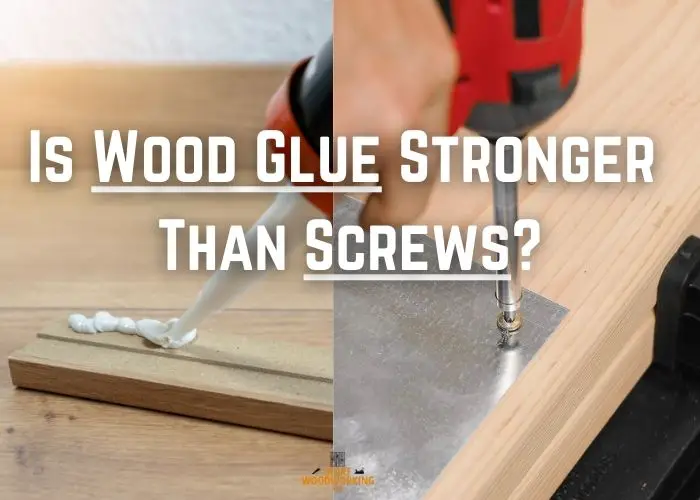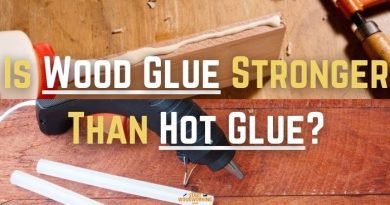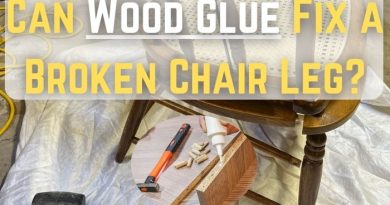Is Wood Glue Stronger Than Screws? The Surprising Truth
Is wood glue stronger than screws? It’s a question that’s been debated among woodworkers for decades. In this blog post, we’ll dive into the world of wood glue and screws, comparing their strengths and weaknesses to help you determine which one is best for your next woodworking project.
Yes, wood glue is generally stronger than screws. When applied correctly, wood glue bonds materials at the molecular level to form an incredibly strong joint that is stronger than the wood itself. Glue spreads stresses evenly across the bond line, preventing failures. While screws provide mechanical fastening, they concentrate stresses at specific points which can cause wood to split or the screw to pull out over time under heavy loads or vibration. For most furniture and woodworking projects where enduring strength is required, wood glue delivers a permanent bond that will not weaken, making it the superior choice to screws on the basis of strength alone.
Comparing Strength: Wood Glue Vs. Screws
When it comes to woodworking, choosing the right method of joining two pieces of wood together is crucial for the success and durability of the project. Two of the most common methods are using wood glue or screws.
In this section, I will compare the strength of wood glue and screws and discuss the factors that influence their strength.
In general, wood glue is an excellent choice for creating strong, permanent bonds between two pieces of wood. When applied correctly, wood glue can create a bond that is stronger than the wood itself. However, it’s important to note that wood glue requires a certain amount of time to dry and cure, which can slow down the construction process.
| Application | Glue Strength & Durability | Screw Strength & Durability |
|---|---|---|
| Furniture Construction | Very Strong, permanent bond if cured fully. Glue line won’t weaken over time. | Shear strength depends on the number/size of screws and wood. |
| Cabinetry | Can work but is more rigid and may crack glass over time. | Also suitable, but more prone to joint failure with repeated impacts. |
| Picture Frames | Ideal for strong yet flexible joints that won’t crack glass. | Strong but the joint may loosen over time with use and wood movement. |
| Toys/Novelties | Perfect for strong child-safe construction. | Also ok but small parts could come loose and be a choking hazard. |
| Outdoors | Not as durable in direct sun/weather exposure. | More durable but may still rust or loosen outside. |
| Disassembly | Excellent for structural panels and carcasses. Withstands impacts and vibration. | Reversible fastening allows easy repair/changes. |
| Tension Strength | Glue joints are very strong and rigid against forces. | Screws can shear or pull out under heavy tension loads. |
| Shear Strength | Glue spreads force evenly and prevents shear failure. | Shear strength depends on number/size of screws and wood. |
In summary, glue provides the strongest, most durable bonds for fine woodworking and furniture applications that won’t require disassembly. Screws are better for quick assembly and reversible joining.
Strength Testing
In terms of strength, wood glue can provide a stronger bond than screws when the joint is properly prepared and clamped. In fact, high-quality wood glue can provide a bond that is stronger than the wood itself, making it an ideal choice for many woodworking projects.
However, screws can provide additional support and stability to a joint, making them a better choice for projects that require weight-bearing or where disassembly is necessary. Additionally, screws can be used to join materials other than wood, such as steel or other metals.
When it comes to aesthetics, wood glue can provide an invisible bond that maintains the natural appearance of the wood. Screws, on the other hand, can be visible and can affect the appearance of the project.
When to Use Wood Glue or Screws
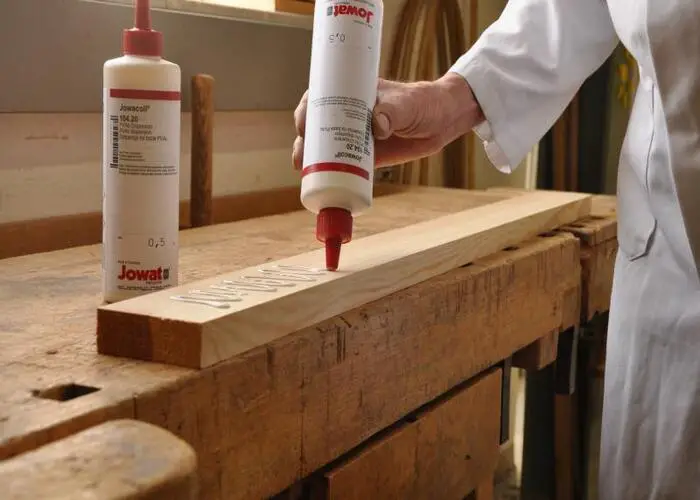
As a carpenter, I often get asked whether wood glue or screws are stronger for woodworking joints. The answer is not straightforward, as both have their advantages and disadvantages.
However, understanding the differences between the two will help you make an informed decision on when to use each.
| Joint Type | Wood Glue Strength | Screw Strength | Best Method |
|---|---|---|---|
| Edge Joint (Butt Joint) | Very Strong – glue penetrates end grain to reinforce fibers | Strong – resists pull-out forces but no wood reinforcement | Glue alone or glue with screws |
| Face Joint | Extremely Strong – glue forms strongest possible bond | Moderate – screws have less surface area than face of board | Glue alone |
| Corner Joint | Very Strong – glue penetrates all surfaces | Strong – screws prevent joint from pulling apart | Glue with screws for reinforcement |
| Lap Joint | Strong – glue bonds faces together | Moderate – screw shear strength but no wood reinforcement | Glue with screws |
| Mortise & Tenon | Extremely Strong – glue penetrates entire joint | Strong – resists pull forces but no fiber reinforcement | Glue alone |
| Dovetail Joint | Incredibly Strong – glue forms chemical bond throughout | Moderate – screws add little strength to joint | Glue alone |
| Laminating Boards | Indistinguishably Strong – glue bonds fibers as one | Moderate – screws may split thin boards | Glue alone |
| Outdoor Projects | Exceptionally Durable – glue resistant to weathering | Prone to Rust/Corrosion over time | Glue alone or with stainless steel screws |
1. Situations where glue excels.
- Permanent structural bonds
- Fine furniture and projects where appearance matters
- Joints subjected to tension or shear forces
- Glue performs better with wood movement/expansion
- Glue bonds are stronger than the wood itself when cured fully
Wood glue is a strong adhesive that creates a bond between two surfaces. When applied correctly, it can create a joint that is stronger than the wood itself.
One of the biggest advantages of wood glue is that it distributes stress evenly across the joint, making it ideal for high-stress projects like furniture. Additionally, wood glue is easy to use, and it doesn’t require any special equipment to apply.
Another advantage of wood glue is its versatility. It can bond a variety of materials, including hardwoods, softwoods, and even broken wood.
Wood glue is also water-resistant, making it suitable for outdoor projects. It can fill gaps in joints, creating a smooth finish. Finally, wood glue dries clear, making it ideal for projects where visibility or aesthetics are important.
| Wood Glue Type | Suitable Wood Types | Notes |
|---|---|---|
| PVA (Polyvinyl Acetate) | – Softwoods (e.g., Pine, Cedar) | – Suitable for general woodworking projects. |
| – Hardwoods (e.g., Oak, Maple) | – Dries clear, easy to use, and non-toxic. | |
| – Plywood and MDF | – Not recommended for outdoor or wet conditions. | |
| Aliphatic Resin (Yellow Glue) | – Hardwoods (e.g., Oak, Birch) | – Provides a strong bond similar to PVA glue. |
| – Softwoods (e.g., Pine, Redwood) | – Suitable for indoor projects with good strength. | |
| – Plywood and MDF | – Dries yellow, sands well, good for visible joints. | |
| Polyurethane (Waterproof Glue) | – Exotic Hardwoods (e.g., Teak, Ipe) | – Suitable for outdoor projects and water exposure. |
| – Softwoods and Hardwoods | – Expands as it cures, filling gaps in joints. | |
| – Plywood and MDF | – Provides a waterproof bond. | |
| Epoxy Resin | – All Wood Types | – Ideal for bonding dissimilar materials. |
| – Suitable for hardwoods, softwoods, and exotics. | – Excellent for structural and high-stress joints. | |
| – Plywood and MDF | – Requires precise mixing, strong and durable. | |
| Hide Glue | – Antique Furniture Restoration | – Traditional glue, used for period furniture. |
| – Softwoods and Hardwoods | – Requires heating for application. | |
| – Veneer and delicate work | – Offers reversible joints for repairs. |
2. Tips for effective glue application.
- Clean and dry surfaces for optimal adhesion
- Clamp until fully cured for maximum strength
- Use appropriate glue for the wood types and conditions
Disadvantages of Wood Glue
While wood glue is strong, it does have some disadvantages. One of the biggest drawbacks is its curing time. It can take several hours for the glue to dry, and even longer for it to reach its full strength.
This means that clamping is required to hold the joint in place while the glue dries. Additionally, wood glue is not as strong as other adhesives like epoxy or polyurethane glue. It also doesn’t work well on surfaces that are not flat, as it requires a large surface area to create a strong bond.
Another disadvantage of wood glue is that it is not easy to disassemble joints that have been glued. This means that if you need to make changes to your project, you may have to break the joint and start over.
Finally, wood glue is not suitable for projects that require a lot of weight-bearing capacity, as it can break down over time.
When to Use Screws
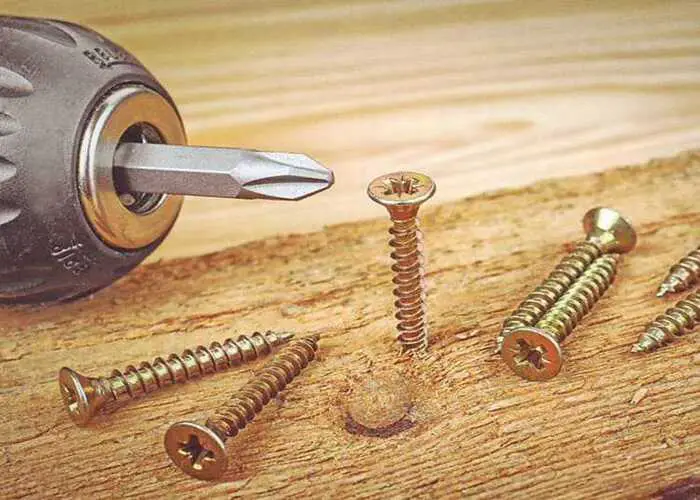
Screws are fasteners that are used to hold two pieces of wood together. They are easy to use and provide a strong bond. One of the biggest advantages of screws is their ability to hold weight. They are ideal for projects that require a lot of weight-bearing capacity, such as building a table or a bookshelf.
1. Situations where screws are preferable.
- Temporary or test assembly joints
- Applications requiring regular disassembly
- Hidden pocket hole joints for ease of construction
Another advantage of screws is their ease of use. They require no clamping and can be easily removed if you need to make changes to your project. Additionally, screws can be used on surfaces that are not flat, making them ideal for projects that require a pocket hole joint or a miter joint.
| Wood Screw Type | Suitable Wood Types | Notes |
|---|---|---|
| Flathead Wood Screw | – Softwoods (e.g., Pine, Cedar) | – Suitable for general woodworking applications. |
| – Hardwoods (e.g., Oak, Maple) | – Available in various lengths and thicknesses. | |
| – Plywood and MDF | – Flat head provides a flush finish on the surface. | |
| Roundhead Wood Screw | – Softwoods and Hardwoods | – Traditional design with a rounded top. |
| – Plywood and Particleboard | – May require countersinking for a smooth surface. | |
| Ovalhead Wood Screw | – Softwoods and Hardwoods | – Oval-shaped head for a decorative finish. |
| – Plywood and MDF | – Provides a more refined appearance. | |
| Panhead Wood Screw | – Softwoods and Plywood | – Pan-shaped head with a flat bottom. |
| – Particleboard and MDF | – Versatile for a range of woodworking projects. | |
| Wood Lag Screw | – Hardwoods (e.g., Oak, Walnut) | – Ideal for heavy-duty applications and structural framing. |
| – Pressure-Treated Softwoods | – Provide strong holding power in larger sizes. | |
| – Construction Timber | – Used in building and framing projects. | |
| Wood Pocket Hole Screw | – Softwoods and Hardwoods | – Designed for pocket hole joinery. |
| – Plywood and MDF | – Often used in cabinetry and furniture construction. | |
| – Particleboard and Melamine | – Provide strong, concealed joints. |
https://startwoodworkingnow.com/types-of-wood/
2. Tips for proper screw usage.
- Predrill pilot holes to prevent splitting
- Use screws long enough to grip deep into wood
- Drive screws straight in without overtightening
Disadvantages of Screws
While screws are strong, they do have some disadvantages. One of the biggest drawbacks is their appearance. Screws can be unsightly and may not be suitable for projects where aesthetics are important. Additionally, screws can split wood if they are not pre-drilled or if the pilot hole is too small. They also require countersinking to create a flush finish.
Another disadvantage of screws is that they can cause stress on the wood fibers, which can weaken the joint over time. Finally, screws are not suitable for projects that require a completely invisible joint.
In summary, glue creates durable, high-strength bonds ideal for fine woodworking and furniture. Screws are better for quick assembly, convenience joints that need to come apart later. With the right fastening method selected for the job, woodworkers can maximize both the strength and aesthetics of their projects.
Frequently Asked Questions
Yes, you can use wood glue and screws together to create a stronger joint. However, be sure to clamp the joint while the glue dries to ensure a strong bond.
There are several types of wood glue available, including PVA glue and polyurethane glue. Choose a high-quality wood glue that is suitable for your project and the type of material you are working with.
Yes, you can use screws on painted wood. However, be sure to use stainless steel screws to prevent rusting.
Wood glue works best on bare wood surfaces, as it requires a porous surface to create a strong bond. If using wood glue on painted wood, it is important to sand the surface to create a rough texture for the glue to adhere to.

